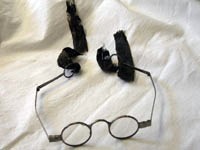Klopstock, als gefeierter Jung-Dichter, wurde während seines Aufenthaltes in Zürich 1750/1751 von Johann Caspar Füssli d. Ä. gemalt. Ewald von Kleist kaufte das Gemälde in Zürich (1752) und übergab es auf der Rückreise (1753) in Halberstadt an seinen Freund Johann Wilhelm Ludwig Gleim. Auf der Gemälderückseite findet sich eine nicht mehr vollständig zu entziffernde Pinselschrift, die lautet: "Klopstock gemalt zu Zürich von... [unleserlich] und Gleimen geschenkt von Kleist". Gleim schenkte Meta Klopstock, der ersten Frau des Dichters, das Gemälde. Aus dem Besitz der Nachkommen einer Cousine Klopstocks wurde es dem Klopstockhaus übereignet.
en

